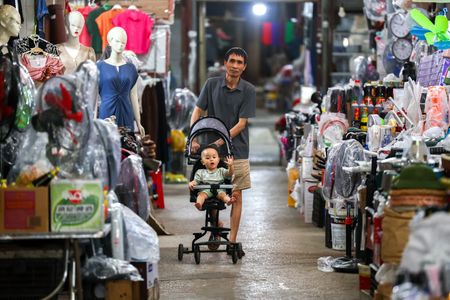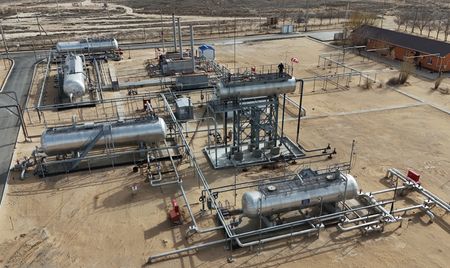By Nick Carey, Victoria Waldersee and Brian Thevenot
SHANGHAI (Reuters) -China’s annual auto shows have become the world’s premier showcase for the rise of ever-cheaper, high-tech electric vehicles from domestic brands in the world’s biggest car market.
But the Shanghai auto show opened on Wednesday amid industry-wide uncertainty over how the U.S.-China trade war could sap demand and upend supply chains as about 70 automakers launched more than 100 new models into a crowded market with more losers than winners.
Automakers also wrestled with a Chinese government crackdown, announced last week, on the marketing of smart-driving systems that many industry executives view as the next technological battleground here.
Automakers pivoted to a safety-first message at the show after regulators banned terms including “smart driving” and “autonomous driving.” The rules followed a March fatal accident of a Xiaomi SU7, a popular Chinese-brand EV, involving the car’s driver-assistance system.
Xpeng, which touts its AI-driven driver-assistance technology, said it would launch a safety “training camp” for drivers.
“We will emphasise the capability boundaries of the driving-assistance functions to ensure safety,” Xpeng CEO He Xiaopeng told reporters.
U.S. President Donald Trump’s 145% import taxes on Chinese imports – and Beijing’s retaliatory tariffs – have pushed global growth forecasts lower as automotive companies confront new risks. Chinese automakers also face European Union tariffs.
As the auto show began Wednesday, U.S. auto-industry groups sent a letter to Trump urging a repeal of 25% tariffs on imported auto parts, warning of rising vehicle prices and falling sales.
SIGNS OF TROUBLE
Chinese vehicle demand has held up so far this year. Auto sales through March were up 12.5%, with gains led by China’s top two automakers, BYD and Geely.
But there are signs of trouble. Chinese cars were already essentially banned from the U.S. market before Trump’s latest flurry of tariffs. China automakers could suffer from weaker demand if the nation’s economy wobbles or Washington pressures other U.S. trade partners to restrict China trade.
Trump’s China tariffs impact automakers globally. Japanese automaker Nissan, for instance, had planned to export up to 200,000 vehicles annually from China factories as its sales in that market have plunged in recent years.
Now, the automaker can’t export those vehicles to the United States, among its biggest markets.
“I don’t know how bad it will get. I don’t know how extreme some people or some governments will get,” Nissan’s China chief and former CFO Stephen Ma said. “Even though I have lived and worked in the U.S. for a long time, I could not have anticipated this.”
Trump’s trade war is also hitting closer to home. Tesla, run by Trump ally Elon Musk, has suspended orders for its Model S and Model X because of China’s counter-tariffs and paused some imports of China-sourced parts for the vehicles.
‘SMART DRIVING’ CRACKDOWN
Chinese automakers, led by BYD, have been aggressively marketing their assisted-driving technology and offering it at lower cost – or free – to gain a competitive edge.
“Electrification” was the first phase of China’s auto-industry development, said Bo Yu, a China-market expert from research firm Jato Dynamics. “Now it’s all about what we call ‘smartification.'”
BYD recently challenged rivals by offering its “God’s Eye” assisted-driving technology across its lineup for free. But it skipped any mention of the technology in Shanghai press conferences where it unveiled models its low-cost Seal 06 and Sealion 06, along with luxury models.
Xpeng CEO He, at a Hong Kong press conference before the show, said it might take a decade or more for the industry to safely develop fully autonomous-driving systems, which face steep regulatory and legal hurdles.
Yale Zhang of Shanghai-based consultancy Automotive Foresight lauded the caution on autonomous technology.
“No matter how advanced the technology is,” he said, “it is meaningless if it leads to casualties.”
‘CHINA SPEED’
China’s hyper-competitive market remains a minefield for foreign brands.
Matt Noone, a design executive at General Motors’ Buick brand, said the brand has scrambled to match China automakers’ speed and technological prowess.
“The alarming thing at this show is the enormous amount of technology and content that’s being given to customers at such a low price,” he said, referencing assisted-driving features on entry-level Chinese vehicles. “How do you make money on that?! Are you making money on that?”
Noone said Buick models had to “earn their way” into the lineup by being profitable, which has driven the brand to cut its lineup in half to about 10 models.
Volkswagen, once China’s top-selling passenger car brand, saw sales drop 6% in the first quarter. The German automaker unveiled the first of five VW and Audi models Wednesday under an electronic banner reading “CHINA SPEED.”
General Motors’ Cadillac showed off an all-electric lineup of models – the Lyriq, Optiq, Vistiq and Escalade IQ.
“This shows that GM sees Cadillac as its best bet to get back into China in a big way,” said Tu Le, founder of consultancy Sino Auto Insights.
But GM, he said, will have to sell Cadillac in China for less than in the United States.
Foreign brands face a stiff challenge in catching up to their Chinese competitors, said Andrew Fellows, global head of automotive and mobility at technology consultancy Star.
“The Western carmakers slept their way through the pandemic while the Chinese rode the EV revolution,” he said. “They’re going to find it hard to dislodge the local carmakers.”
(Reporting by Zhang Yan, Qiaoyi Li, Victoria Waldersee, Nick Carey, Casey Hall, Zhuzhu Cui and Brian Thevenot; Writing by Kevin Krolicki and Brenda Goh; Editing by Jamie Freed and Bernadette Baum)












